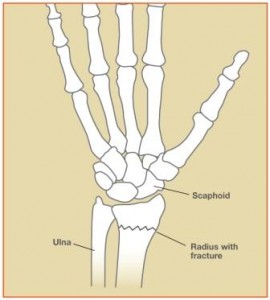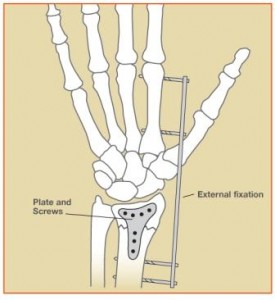What is a wrist fracture?
The wrist is made up of eight small bones and the two forearm bones, the radius and ulna (see Figure 1). The bones come together to form multiple large and small joints. At each joint, the ends of the bones are lined with a very smooth covering (cartilage). The bones are held together by ligaments. The shape and design of these joints allow the wrist to bend and straighten, move side-to-side, and rotate, as in twisting the palm up or down.
A wrist fracture may occur in any of these bones when enough force is applied to the wrist, such as when falling down onto an outstretched hand. Severe injuries may occur from a more forceful injury, such as a car accident or a fall off a roof or ladder. Osteoporosis, a common condition in which the bone becomes thinner and more brittle, may make one more susceptible to getting a wrist fracture with a simple fall.

Figure 1
The most commonly broken bone of the wrist is the radius (see Figure 1). Many people think that a fracture is different from a break, but they are the same. When the wrist bone is broken, there is pain, swelling, and decreased use of the hand and wrist. Often the wrist appears crooked and deformed. Fractures of the small wrist bones, such as the scaphoid, are unlikely to appear deformed (see Figure 1) to the left.
Wrist fractures may be simple with 1 or 2 large bone pieces that are well aligned and stable. Other wrist fractures are unstable, which implies that the bone fragments tend to displace or shift, which may cause the wrist to appear crooked. Some wrist fractures break the normally smooth, ball bearing-like joint surface; others will be near the joint but leave the joint surface intact. Sometimes the bone is shattered into many pieces, which usually makes it unstable. An open (compound) wrist fracture occurs when a bone fragment breaks through the skin. There is a higher risk of infection with compound (open) wrist fractures. The alignment of the bones once healed may affect the wrist’s function. If the bones heal in a significantly altered position, there may be permanent limitations in motion with an increased risk of arthritis and pain.
How are wrist fractures evaluated?
Examination and x-rays are needed so that your doctor can tell if there is a fracture and assess the position of the bones, in order to help determine the treatment. Occasionally a CT scan may be helpful to get better detail of the fracture fragments. In addition to the bone, ligaments (the structures that hold the bones together), tendons, muscles, and nerves may be injured as well when the wrist is broken. These injuries may need to be treated in addition to the fracture. Whenever the bone protrudes through the skin, it is important to receive immediate care to minimize the risk of bony infection. When numbness in the fingers is present, it implies that the nerves have been injured.
How are wrist fractures treated?
Treatment is dependent on many factors. Patient factors such as age, activity level, hobbies, occupation, hand dominance, prior injuries or wrist arthritis, and other medical problems are very important when considering treatment. Remember, it might only be your wrist, but we all need our hands to perform daily activities. Local factors relate to the bone quality (density – osteoporosis), while others relate to the fracture itself. Certain fractures are simple and in good position with the bone and joints well aligned, whereas others are fragmented into multiple pieces and may be badly displaced. Some fractures are stable and will stay in place, whereas others are unstable and might shift during treatment. It is very important to see a physician with an in-depth understanding of these factors in order to get optimal treatment and outcome.
A splint or cast may be used to treat a fracture that is not displaced, or to protect a fracture that has been set. Usually a cast is worn for several weeks depending on each patient’s fracture and ability to heal the broken bone.

Figure 2
Other fractures may need surgery to properly set the bone and/or to stabilize it. Fractures may be stabilized with pins, screws, plates, rods, or external fixation (Figure 2). Plates and screws that can be placed through an incision on the bottom or top of the wrist are often used to hold the bone fragments in place and may allow early use of the hand and wrist. These implants are buried inside the wrist and usually do not require removal. External fixation is a method in which a frame outside the body is attached to pins which have been placed in the bone above and below the fracture site, in effect keeping it in traction until the bone heals. Sometimes arthroscopy is used in the evaluation and treatment of wrist fractures. Your hand surgeon will determine which treatment is the most appropriate in your individual case.
On occasion, bone may be missing or may be so severely crushed that there is a gap in the bone once it has been re-aligned. In such cases, a bone graft may be necessary. In this procedure, bone is taken from another part of the body, or bone bank or bone graft substitutes are used, to help fill the defect.
While the wrist fracture is healing, it is very important to keep the fingers and shoulder flexible, provided that there are no other injuries that would require that they be immobilized. Once the wrist has enough stability, motion exercises may be started for the wrist itself. Your hand surgeon will determine the appropriate timing for these exercises. Hand therapy is often used to help recover flexibility, strength, and function.
What kind of results can I expect?
Recovery time varies considerably, depending on the severity of the injury, associated injuries, and other factors as noted previously. It is not unusual for maximal recovery from a wrist fracture to take several months. Some patients may have residual stiffness or aching. If the surface of the joint was badly injured, arthritis may develop. On occasion, additional treatment or reconstructive surgery may be needed.
Download the Wrist Fractures PDF


